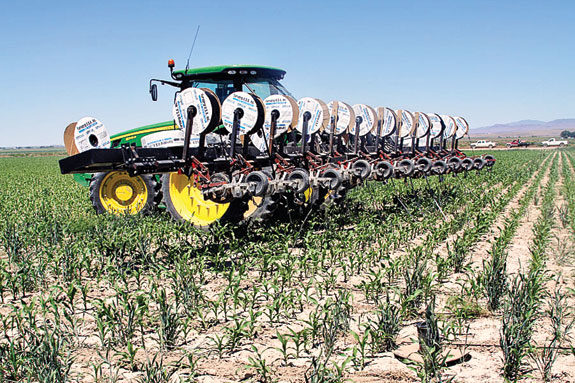Each day is full and extremely busy with the intricate areas of both companies.
TLK Farms, Inc. irrigates approximately 8,500 acres. TLK Dairy, Inc. milks 10,000 head of cattle twice a day.
Linda Ketterling handles all of the bookkeeping for both operations and Launa works diligently in the office with her mom.
Tony works at TLK Dairy, Inc. and does some farming of his own. However, this operation extends beyond the immediate family to their nearly 100 employees.
Terry believes, “Each employee has an equal, important place in this company. This company is where it is today because of the hard work and dedication of each and every person in both operations. My employees work with me, not for me.”
The need for feed
All dairymen know of the need for feed. This need affects all areas of their operation with the critical importance of maintaining or increasing their milk production.
Although Ketterling may have a larger operation than some dairies, he still faces the same concerns and potential setbacks as everyone else.

To address this issue, Ketterling set about to look for ways to better utilize his available resources. He had some bare land, rocky land or pivot corners dependent on inconsistent end guns for irrigation.
The space was available, and he wanted to utilize it in the most productive way, hoping for more feed for his cows. He achieved just that by installing drip irrigation last year in approximately 300 acres of corners in his fields.
What is drip irrigation?
Some ask, “What is drip irrigation and how does it work?” Drip irrigation is installed above the ground or below the soil surface, known as subsurface drip irrigation (SDI).
Custom emitter spacing provides uniformity of water distribution directly to the plant roots. Water flow is controlled through a pressure control valve.
Nutrients and fertilizers (if used) are injected through an injection valve and are completely controlled to meet the custom specifications for the crop, soil, terrain and any other factor specific to a particular situation.
Drip irrigation application results in less water stress, efficient nutrient application, decreased plant disease, specific water flow, elimination of erosion and energy efficiency.

Another benefit of drip irrigation is that it is not affected by weather. A more consistent flow of water is applied directly to the plant roots, unlike other irrigation methods where high winds and extreme heat (evaporation) affect the application, resulting in ineffective water distribution.
Drip irrigation can work in conjunction with the other irrigation methods already in place. Drip, pivot, solid set or wheel lines can partner to maximize the growing of crops, even in areas that were previously not able to be irrigated.
The TLK experience
Once Ketterling made the decision to install a drip system, he worked with Jeff Vogt, Eurodrip USA, and Jonathan Demcak, Droplet Irrigation, to custom design a set-up for his pivot corners.
Once the drip tape was installed, Ketterling used 250 GPM Vacleen filters, moving them from field to field to filter the water through layflat hose and then through the seamless drip tape emitters.
Water flow through Ketterling’s drip system is 150 GPM versus 875 GPM through the pivot. Since Ketterling pumps his water from the Snake River and lifts it to his irrigated farm, the lower operating pressure (approximately 12 to 15 PSI) with drip irrigation has also meant a reduction in energy for pumping.

Ketterling found the drip irrigation to be more efficient, easier, cost-effective and much less labor-intensive than other forms of irrigation.
Labor costs decreased substantially since the removal of the drip tape from his fields took approximately less time and fewer employees.
Additionally, since the drip method waters directly to the plant roots, the corn was tall and even, while in other areas of the fields plants were shorter and uneven or didn’t grow at all.
The corn under drip tasseled first and produced a higher yield than his corn fields with other irrigation methods.
Initial costs for a drip system average approximately $400 per acre, although this can vary depending on terrain, soil, row spacing and other variables, due to the customization for each grower. After the initial investment, annual cost is approximately $150 per acre.
End results
After completing a growing season, Ketterling felt that the benefits received outweighed the initial costs. He was able to grow an additional 300 acres of corn on ground where crops were not grown before, at a 28-ton yield and a price of $45 per ton.
The reduction in labor, fuel and power costs also contributed to his bottom line.
He is pleased with the results of his drip-irrigated corners and has learned a lot to continue to improve and fine-tune for next year.
When asked about the main benefit from making this change, Ketterling replied, “Well, what I like best about drip irrigation is that I have 300 more acres of feed this year, and that’s critical.” FG
Patti Bennett Brown is a freelance author and photographer based in Nampa, Idaho.
PHOTOS:
FIRST: The one-of-a-kind 40-foot-wide tape injector was used to install drip tape in the corn fields.
SECOND: After running water through the portable filter, custom emitter spacing on the seamless drip tape provides uniformity of water distribution directly to the plant roots.
THIRD: To prepare for harvest, this tape lifter helped remove drip tape from the field.
FORTH: Portability of the filter made hauling it from one field to another simple and easy. Photos courtesy of Patti Bennett Brown.











